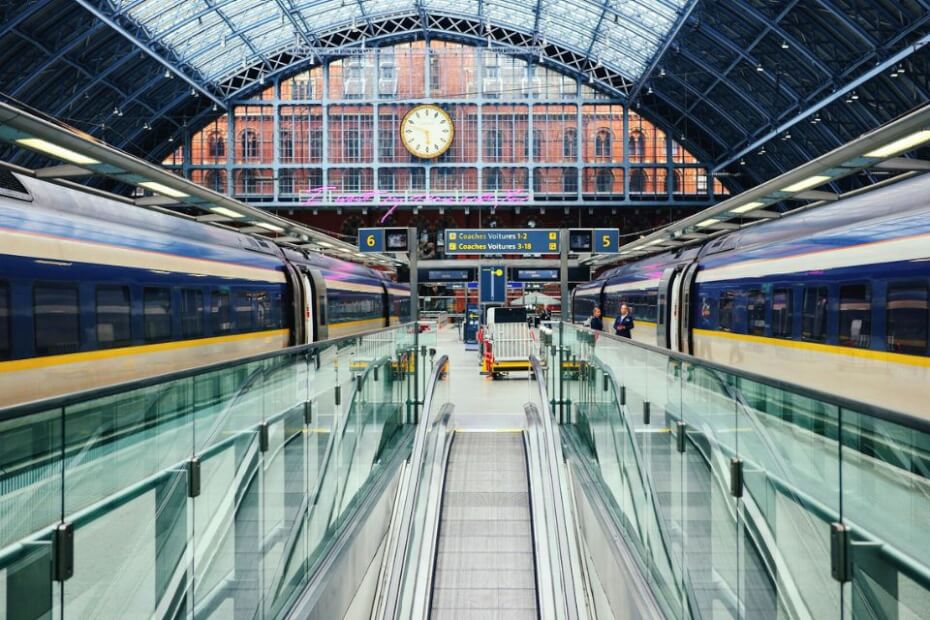
A rail operator says London’s St. Pancras Station may be unable to handle the European Union’s (EU’s) new Entry/Exit System (EES) without hour-long queues.
The international high-speed cross-country rail service may bring fewer passengers to and from the United Kingdom (UK).
High Speed 1 (HS1) warned that preparations for the EU’s EES at London’s St. Pancras station are “severely inadequate.”
HS1 owns and operates the line and stations between London and the Channel Tunnel.
It connects the international high-speed routes from London to Paris, Brussels, and Amsterdam and the domestic route from London to Kent.
The Guardian reported that the company expressed concern that this could lead to delays and potentially limit Eurostar’s services.
Eurostar is the international high-speed rail service connecting Belgium, France, Germany, the Netherlands, and the United Kingdom.
It runs about 14 trains to Paris from St Pancras daily, each carrying up to 900 passengers.
EU’s new biometric border check system
Under the EU’s Entry/Exit System (EES), non-EU citizens traveling to the Schengen Area must record fingerprints and facial scans at the border.
This includes both short-stay visa holders and visa-exempt nationals, including British citizens.
Instead of passport stamping upon arrival, the EES will document entries and exits electronically using the traveler’s biometric data.
A border officer will supervise registering travelers’ biometric data upon arrival at the EU border.
This will only happen during their first visit after the EES rollout. Their data will be valid in the EES system for three years.
Travelers can confirm their permission by fingerprint or facial biometrics on their subsequent visits within that time.
Each time travelers enter the Schengen area, the EES system will store travelers’ data for three years or until the traveler’s passport expires.
Eurostar may limit passengers to avoid long queues
The UK Parliament’s European Scrutiny Committee has been gathering evidence to help examine and understand how the EU’s Entry/Exit System (EES) will affect travel.
HS1 is one of the latest parties to raise concerns about the EES. The EU’s new border check system is set to come into force in October 2024.
In its evidence report submitted to the Committee, HS1 said it needs 49 more EES kiosks to process passenger checks.
However, the French government had only proposed 24. HS1 was told that the EES kiosks were optional, as checks could be done at the border.
HS1 warned it would cause “unacceptable passenger delays of many hours and potential capping of services.”
The company anticipated that with only 24 EES kiosks, Eurostar would be unable to process all passengers. This would especially cause delays during the morning peak hours.
It could also “lead to services having to be capped in terms of passenger numbers,” HS1 warned.
HS1 also stated that it would be difficult to implement the EES at St. Pancras station due to limited space restrictions.
The lack of space would make the queuing process “convoluted and staggered,” it added.
More EES kiosks would mean a more complex passenger flow
According to Eurostar’s evidence report to the UK’s European Scrutiny Committee, more Entry/Exit System (EES) kiosks would only create new queues.
It would also mean a “higher risk for the delivery of the timetable and the growth of rail transport from St Pancras,” its evidence stated.
Eurostar has stated that implementing the EU’s EES would increase the processing time for border control by “two to three minutes.”
This would be significantly longer than the current processing time of 45 seconds and could lead to peak time queues of over an hour.
Extra EES kiosks at St Pancras would cost £25,000 each and £2 million per year on operation and maintenance costs.
Should extra kiosks prove to be a viable solution, these additional costs would need to be funded by Eurostar.
Port border concerns on Entry/Exit System rollout
The UK’s European Scrutiny Committee has previously warned of 14-hour-long queues at the Port of Dover.
The excessive waiting time is due mainly to travelers arriving in cars or coaches at the border controls.
Passengers would need to disembark to register and submit to biometric checks and then get back in their vehicle.
The Ashford Borough Council also expressed concerns that the EU’s EES could severely impact ferry operations due to its inability to handle current car and coach volumes.
Lengthy delays at the port could lead to traffic congestion on major roads, affecting access to the Eurotunnel in Folkestone.
This could disrupt the local economies and cause welfare concerns for passengers and communities.
Averting the EES’s severe impact on UK-EU travel
HS1 has called for a gradual implementation of the Entry/Exit System to prevent any “serious disruption” in UK-EU train travel.
Another is to allow passengers to register biometric data in advance online instead of being supervised by officers at the border.
This has been the call from Eurostar and HS1, as registration upon arrival would significantly strain train stations’ limited spaces.
Eurostar also wants politicians to be able to use an “emergency brake” if the EES causes longer queues.
Still, despite the challenges, Eurostar and many airline companies see EES as beneficial in the long term.
The UK’s European Scrutiny Committee is also looking at the interoperability among the EES, ETIAS, and UK ETA systems.
Along with the EES, the EU will implement the new European Travel and Information and Authorization (ETIAS) in mid-2025.
Visa-exempt nationals, including UK citizens, will need an EITAS to visit the Schengen Area.
It is similar to the UK’s Electronic Travel Authorization (ETA), which is mandatory for all non-visa nationals visiting the UK.

